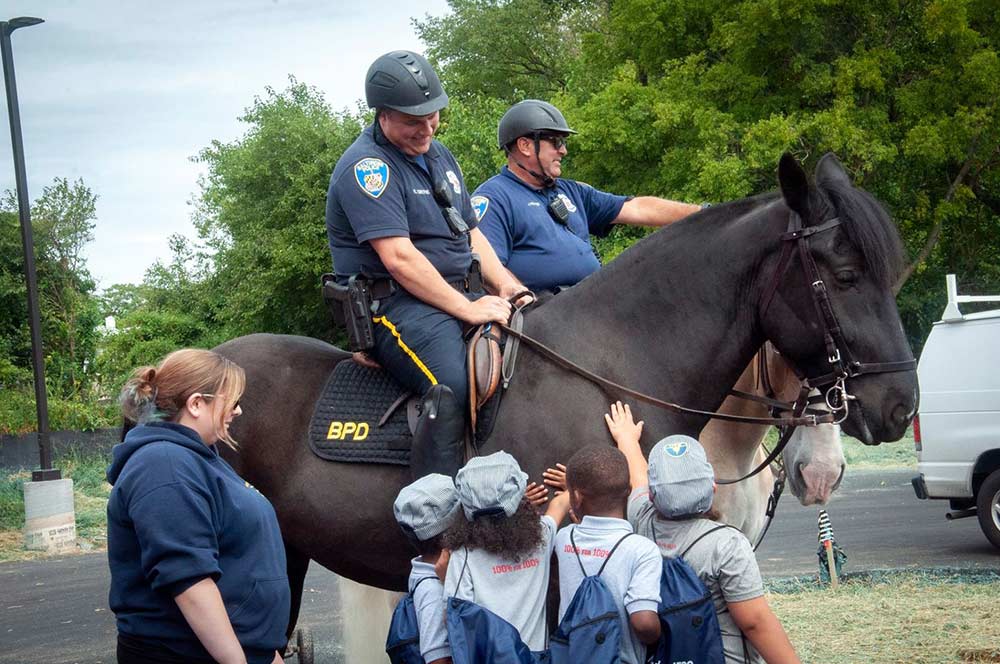
Just under a year ago, the Baltimore Police Mounted Unit was on the verge of being put out to pasture, its budget axed by the City Council during a contentious debate over the future of police funding.
But reports of the demise of the oldest continuously operating mounted police unit in the country were premature.
Today, after a reprieve from the former Baltimore mayor, the 133-year-old unit’s horses are living large, occupying a spanking new, state-of-the art stable alongside the B&O Railroad’s historic right-of-way. It features huge, open stalls, wide aisleways, a heated washroom and construction designed for optimal ventilation, along with a fire suppression system. There are offices and a community room with kitchen facility, designed for use as educational space.
The $3.5 million, privately-funded First Mile Stable was the brainchild of the B&O Railroad Museum which owns the property adjacent to the “first mile” of American railroad built in 1830. The museum’s executive director, Kris Hoellen, said it was a natural fit given the historic connection between horses and railroads, dubbed “Iron Horses” in the early 19th century as the new mode of transportation of the era.
The new stable is a far cry from the old auto dealership under the busy Jones Falls Expressway that housed the unit until last October. The horse stalls had no windows and the “exercise” area was postage-stamp-sized bare lot.
On a sunny morning last month, two of the unit’s three draft horses, Bo and Jack, were grazing in paddocks fashioned inside the concrete remains of an old railroad repair shop, once used as a grim set in the hit HBO crime drama series “The Wire.” The third horse, Slurpee (named by donor 7-Eleven stores), was luxuriating in his 16 x 16-foot stall.
The unit, which once handled crowd control among other duties, has been repurposed by the Baltimore Police Department solely for community relations activities under the Department of Recreation and Parks. The four officers and a sergeant are assigned to the police department’s Community and Youth Division.
Some Baltimore racial justice activists, who want the police budget reduced in the wake of a string of deaths of people of color at the hands of police officers across the country, feel the unit’s $500,000 annual line item could be better spent on education and social services.
“What’s the benefit?” asked Jane Henderson, executive director of Communities United, which focuses on racial and social justice issues. “I would rather see a narrowing of police roles to emergency responder with a gun, not simply social services under police purview.”
But community leaders in the impoverished southwest neighborhood of Mount Clare where the stable is located, say the benefits of the mounted unit are clear to residents who have viewed police as a threatening presence.
“The horses are welcoming,” said Kintira Barbour, president of the Mount Clare Community Council. “They bring a sense of joy.”
Already, the equine and human officers are engaged in community activities, greeting train carloads of visitors each day who take a short ride on the historic rail line from the museum to the stable for tours.
Hoellen, who bubbles with excitement about the possibilities of improving both police-community relations and the neighborhood, said she views the stable project as the museum’s moment to step up as a “responsible anchor” in the Mount Clare area.
“Children want to know what horses eat, how big are they,” she said, describing how small interactions can make a difference. “It may be their very first conversation with a police officer.”
She sees the story-telling, singing and dancing sessions held now for toddlers growing into programming for older students in animal husbandry, equine studies and law enforcement. Hoellen said museum educators are working with the Maryland Horse Council to develop a curriculum to serve the some 70,000 children who visit the museum each year.
Hoellen also hopes the equine program will inspire young people to become involved with horses through free city riding programs, like City Ranch, which brings horses to young people in their communities.
Hoellen said the stable is looking for a donated riding lawn mower and horse tack. Monetary donations are being accepted to assist with acquiring additional horses and with helping to finance the stable. In addition, naming opportunities are available for the stalls and the stable itself. Contact khoellen@borail.org




